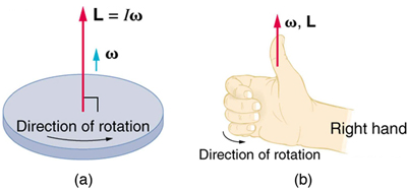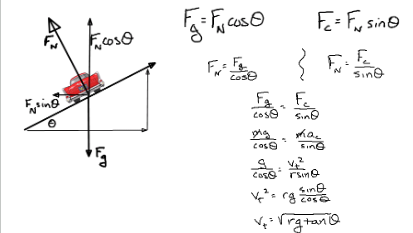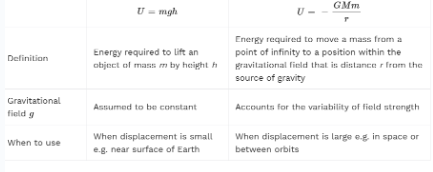Chapter 7
1/56
Earn XP
Name | Mastery | Learn | Test | Matching | Spaced |
|---|
No study sessions yet.
57 Terms
Axis
center point around which circular motion occurs
Rotation
circular motion around an internal axis
Revolution
circular motion around an external axis
Period, T
time it takes to make one complete oscillation; SI unit- s
Frequency, f
number of cycles made in a given time, usually a second; SI unit- Hz, 1/s, or s-1
Angular Displacement, θ
angle through which an object rotates; positive is counter clockwise and negative is clockwise
Angular Displacement SI Unit
radian
Angular Displacement convert measurements of
360° degrees = 2π
Angular Displacement equation
s/r; arc length / radius
Angular Velocity, ω
rate of angular displacement
Angular Velocity Equation
ω = Δθ/t
Angular Velocity SI unit
rad/s
Angular Velocity Right Hand Rule
the direction in which the thumb of your right hand points when you curl your fingers in the direction of rotation

Does angular speed depend on radius?
No
Tangential Velocity, vt
the speed and direction of an object moving in a circle; direction is always tangent to the circle; aka linear speed
Tangential Velocity Equations
vt = rω
vt = 2πr/T or = C/T
Does tangential speed depend on radius?
Yes
Tangential Velocity SI Unit
m/s
UCM
motion of an object travelling at a constant speed in a circular path with fixed radius; use circumference (C = 2πr or C = πd)
Speed of an object in UCM equation
vt = 2πr/T
How does an object accelerate if it’s moving at a constant speed?
For an object in UCM the magnitude of tangential velocity is constant but its direction is constantly changing (varying velocity) and therefore, accelerate even with constant speed (same magnitude of velocity)
Centripetal Acceleration, ac
acceleration towards a circle’s center
Centripetal Acceleration Equations
ac = vt2/r
ac = rω2
Centripetal Force, Fc
force that causes centripetal acceleration. It isn’t a new force, just a force caused by something pulling inward, such as friction, weight, or tension
Centripetal Force Equation
Fc = m ac
Un-banked curve
a curve that is not inclined above the horizontal, ex: level
What force holds an object in an unbanked curve?
friction causes the centripetal force
Un-banked curve equation to determine maximum speed
Fc = Fs → vt = sqrt(usgr)
Banked Curves
incline; inclining the turn in the axial direction
What is the main reason an object stays on a banked curve?
reduces the reliance on friction when turning the corners
Banked Curve equation to determine maximum speed
Fg = FNcos(θ) & Fc = FNsinθ → vt = sqrt(rgtanθ)

Angular Acceleration, α
when circular motion is nonuniform; rate of angular velocity changes
Angular Acceleration Equation
α = Δω/t
Angular Acceleration SI unit
rad/s2
Angular Acceleration Right Hand Rule
find angular velocity with right hand rule then extend thumb to point in direction of angular velocity then:
If the angular velocity points upward and is increasing, then the angular acceleration points in the same direction as angular velocity. If the angular velocity is decreasing, then the angular acceleration points in the opposite direction of the angular velocity. Likewise, if the angular velocity is pointing downward and is increasing, then the angular acceleration also points downward. On the other hand, if the angular velocity points downwards and is decreasing, then the angular acceleration points upward
Rotational Kinematic Equations
ω = ωο + αt
θ = ω t
θ = ωot + ½αt2
ω2 = ωo2 + 2αθ
* only if acceleration is constant
Tangential Acceleration, at
if tangential speed changes, an acceleration is occurring.
Tangential Acceleration Equation
at = rα
Tangential Acceleration SI unit
m/s2
Total Acceleration, a
vector sum of centripetal and tangential acceleration
Total Acceleration equation
a2 = ac2 + at2
Newton’s Law of Universal Gravitation
Calculate the gravitational force on objects given mass and position
ag/g = (RE/r)2
Where:
g = 9.80m/s2
RE = earth’s radius
r = distance between center of earth and center of the object
Gravitational Potential Energy, Ug
potential energy for object’s far from earth’s surface, like satellites; for two point masses separated by distance
Gravitational Potential Energy equation
Ug = (-Gm1m2)/r
r = distance between earth’s center and the mass
As distance away increases, U becomes
less negative (closer to zero), meaning the object is free of the gravitational field
When to use different potential energies

Satellites in Circular Orbit
for a satellite (projectile) to stay in a fixed orbit with a constant radius it must maintain a velocity such that: Fc = Fg → vt = sqrt(Gm/r)

What force holds a satellite in orbit?
centripetal force
Equation to determine speed of a satellite
vt = sqrt(Gm/r)
Kepler’s 1st Law of Planetary Motion
Planets move in elliptical orbits with the sun at one of the focal points
Kepler’s 2nd Law of Planetary Motion
Speed of planets vary during their orbit, they move faster when closer to the sun. Remember conservation of energy. When the potential energy changes, so does the kinetic energy
Kepler’s 3rd Law of Planetary Motion
The period squared is directly proportional to the radius cubed for planets orbiting the sun; T2 = (4π2/GM)R3
Escape Velocity
the satellite’s velocity such that the mechanical energy of the satellite–central-object system is equal to zero; When the only force exerted on a satellite is gravity from a central object, a satellite that reaches escape velocity will move away from the central body until its speed reaches zero at an infinite distance from the central body.
Escape Velocity Equation
vesc = √2GM/R
Why do astronauts on the I.S.S. not experience weight?
it travels around the Earth at such high speed, its travelling forwards equals out the falling and the ISS stays more or less at the same height
Perform calculations to determine a means to simulate gravity
stimulate by spinning; find vt; use Ug equation or vt equations